Possible Factors Driving Groundwater Quality and Its Vulnerability to Land Use, Floods, and Droughts Using Hydrochemical Analysis and GIS Approaches
Abstract
:1. Introduction
2. Study Area Description and Topography
3. Geological and Hydrological Setting
3.1. Geology
3.2. Hydrogeology
4. Data and Methods
5. Results and Discussion
5.1. Linkages between Different Aquifers
5.2. Groundwater Quality Indices Trends
5.3. Impacts of Land Use Changes on Groundwater in Wadi El-Assiuti
5.4. Impacts of Climate Change on Groundwater in Wadi El-Assiuti
5.5. Flooding and Drought
5.6. Role of Fault System in Groundwater Recharge
6. Conclusions
Author Contributions
Funding
Institutional Review Board Statement
Informed Consent Statement
Data Availability Statement
Acknowledgments
Conflicts of Interest
References
- Hu, Z.; Wang, L.; Wang, Z.; Hong, Y.; Zheng, H. Quantitative assessment of climate and human impacts on surface water resources in a typical semi-arid watershed in the middle reaches of the yellow river from 1985 to 2006. Int. J. Climatol. 2015, 35, 97–113. [Google Scholar] [CrossRef]
- Sang, Y.F.; Wang, Z.; Liu, C.; Yu, J. The impact of changing environments on the runoff regimes of the arid Heihe River basin, China. Theor. Appl. Climatol. 2014, 115, 187–195. [Google Scholar] [CrossRef]
- He, Z.; Wang, Z.; Suen, C.J.; Ma, X. Hydrologic sensitivity of the upper san joaquin river watershed in California to climate change scenarios. Hydrol. Res. 2013, 44, 723–736. [Google Scholar] [CrossRef] [Green Version]
- Rehana, S.; Mujumdar, P.P. River water quality response under hypothetical climate change scenarios in Tunga-Bhadra river, India. Hydrol. Process. 2011, 25, 3373–3386. [Google Scholar] [CrossRef] [Green Version]
- Chenini, I.; Khemiri, S. Evaluation of ground water quality using multiple linear regression and structural equation modeling. Int. J. Environ. Sci. Technol. 2009, 6, 509–519. [Google Scholar] [CrossRef] [Green Version]
- Joarder, M.A.M.; Raihan, F.; Alam, J.B.; Hasanuzzaman, S. Regression analysis of ground water quality data of Sunamganj District, Bangladesh. Int. J. Environ. Res. 2008, 2, 291–296. [Google Scholar]
- Masoud, A.M.; Ali, M.H. Coupled multivariate statistical analysis and WQI approaches for groundwater quality assessment in Wadi El-Assiuty downstream area, Eastern Desert, Egypt. J. Afr. Earth Sci. 2020, 172, 103982. [Google Scholar] [CrossRef]
- Farrag, A.A.; Ebraheem, M.O.; Sawires, R.; Ibrahim, H.A.; Khalil, A.L. Petrophysical and aquifer parameters estimation using geophysical well logging and hydrogeological data, Wadi El-Assiuoti, Eastern Desert, Egypt. J. Afr. Earth Sci. 2019, 149, 42–54. [Google Scholar] [CrossRef]
- Abotalib, A.Z.; Heggy, E. Groundwater Mounding in Fractured Fossil Aquifers in the Saharan-Arabian Desert. In Advances in Science, Technology and Innovation; Springer: Cham, Switzerland, 2019; pp. 359–362. [Google Scholar] [CrossRef]
- Hussien, H.M.; Kehew, A.E.; Aggour, T.; Korany, E.; Abotalib, A.Z.; Hassanein, A.; Morsy, S. An integrated approach for identification of potential aquifer zones in structurally controlled terrain: Wadi Qena basin, Egypt. Catena 2017, 149, 73–85. [Google Scholar] [CrossRef]
- Farrag, A.A. On the Groundwater Assessment and Management in Wadi El Assiuti, Eastern Desert, Egypt. In Proceedings of the Fifth International Conference on the Geology of Africa, Assiut, Egypt, 23–24 October 2007; pp. 15–48. [Google Scholar]
- Abu El-Ella, E. Hydrogeochemical evolution of groundwater aquifers in the area east of Assiut Nile Basin, Egypt. Bull. Fac. Sci. Assiut Univ. 1999, 28, 1–16. [Google Scholar]
- Venegas-Quiñones, H.L.; Thomasson, M.; Garcia-Chevesich, P.A. Water scarcity or drought? The cause and solution for the lack of water in Laguna de Aculeo. Water Conserv. Manag. 2020, 4, 42–50. [Google Scholar] [CrossRef]
- Wang, R.; Kalin, L.; Kuang, W.; Tian, H. Individual and combined effects of land use/cover and climate change on Wolf Bay watershed streamflow in southern Alabama. Hydrol. Process. 2014, 28, 5530–5546. [Google Scholar] [CrossRef]
- Niraula, R.; Meixner, T.; Norman, L.M. Determining the importance of model calibration for forecasting absolute/relative changes in streamflow from LULC and climate changes. J. Hydrol. 2015, 522, 439–451. [Google Scholar] [CrossRef]
- Irawan, D.; Puradimaja, D. Geological Mapping and Groundwater Physical-Chemical Properties Characterization: An Approach to Spring Recharge Area Conservation. In Proceedings of the International Conference on Urban Hydrology for the 21st Century, Kuala Lumpur, Malaysia, 14–16 October 2002. [Google Scholar]
- Singh, S.K.; Singh, C.K.; Mukherjee, S. Impact of land-use and land-cover change on groundwater quality in the Lower Shiwalik hills: A remote sensing and GIS based approach. Cent. Eur. J. Geosci. 2010, 2, 124–131. [Google Scholar] [CrossRef]
- Singh, C.K.; Shashtri, S.; Mukherjee, S.; Kumari, R.; Avatar, R.; Singh, A.; Singh, R.P. Application of GWQI to Assess Effect of Land Use Change on Groundwater Quality in Lower Shiwaliks of Punjab: Remote Sensing and GIS Based Approach. Water Resour. Manag. 2011, 25, 1881–1898. [Google Scholar] [CrossRef]
- Fu, B.; Qiu, Y.; Wang, J.; Chen, L. Effect simulations of land use change on the runoff and erosion for a gully catchment of the Loess Plateau, China. Dili Xuebao Acta Geogr. Sin. 2002, 57, 717–722. [Google Scholar]
- Zhang, L.; Dawes, W.R.; Walker, G.R. Response of mean annual evapotranspiration to vegetation changes at catchment scale. Water Resour. Res. 2001, 37, 701–708. [Google Scholar] [CrossRef]
- Huang, M.; Zhang, L. Hydrological responses to conservation practices in a catchment of the Loess Plateau, China. Hydrol. Process. 2004, 18, 1885–1898. [Google Scholar] [CrossRef]
- Wang, G.; Yang, L.; Chen, L.; Kubota, J. Impacts of land use changes on groundwater resources in the Heihe River Basin. Dili Xuebao/Acta Geogr. Sin. 2005, 60, 456–466. [Google Scholar] [CrossRef]
- Flood Potential Analysis (FPAn) using Geo-Spatial Data in Penampang area, Sabah. Mal. J. Geo. 2017, 1, 1–6. [CrossRef]
- Dams, J.; Woldeamlak, S.T.; Batelaan, O. Predicting land-use change and its impact on the groundwater system of the Kleine Nete catchment, Belgium. Hydrol. Earth Syst. Sci. 2008, 12, 1369–1385. [Google Scholar] [CrossRef] [Green Version]
- Barringer, T.; Dunn, D.; Battaglin, W.; Vowinkel, E. Problems and Methods Involved in Relating Land Use To Ground-Water Quality. J. Am. Water Resour. Assoc. 1990, 26, 1–9. [Google Scholar] [CrossRef]
- Bhaduri, B.; Harbor, J.; Engel, B.; Grove, M. Assessing watershed-scale, long-term hydrologic impacts of land-use change using a GIS-NPS model. Environ. Manag. 2000, 26, 643–658. [Google Scholar] [CrossRef] [PubMed]
- Liu, Y.; Zhang, K.; Li, Z.; Liu, Z.; Wang, J.; Huang, P. A hybrid runoff generation modelling framework based on spatial combination of three runoff generation schemes for semi-humid and semi-arid watersheds. J. Hydrol. 2020, 590, 125440. [Google Scholar] [CrossRef]
- El-Rakaiby, M.L. Drainage basins and flash flood hazard in selected parts of Egypt. Egypt J. Geol. 1989, 33, 307–323. [Google Scholar]
- Gheith, H.; Sultan, M. Construction of a hydrologic model for estimating Wadi runoff and groundwater recharge in the Eastern Desert, Egypt. J. Hydrol. 2002, 263, 36–55. [Google Scholar] [CrossRef]
- Abu El-Magd, S.A.; Pradhan, B.; Alamri, A. Machine learning algorithm for flash flood prediction mapping in Wadi El-Laqeita and surroundings, Central Eastern Desert, Egypt. Arab. J. Geosci. 2021, 14, 323. [Google Scholar] [CrossRef]
- Abu El-Magd, S.A. Flash Flood Hazard Mapping Using GIS and Bivariate Statistical Method at Wadi Bada’a, Gulf of Suez, Egypt. J. Geosci. Environ. Prot. 2019, 7, 372–385. [Google Scholar] [CrossRef] [Green Version]
- El Bastawesy, M.; White, K.; Nasr, A. Integration of remote sensing and GIS for modelling fash foods in WadiHudain catchment. Egypt Hydrol. Process. 2009, 23, 1359–1368. [Google Scholar] [CrossRef]
- Abu El-Magd, S.A.; Orabi, H.O.; Ali, S.A.; Parvin, F.; Pham, Q.B. An integrated approach for evaluating the flash flood risk and potential erosion using the hydrologic indices and morpho-tectonic parameters. Environ. Earth Sci. 2021, 80, 694. [Google Scholar] [CrossRef]
- Abu El-Magd, S.A.; Maged, A.; Farhat, H.I. Hybrid-based Bayesian algorithm and hydrologic indices for flash flood vulnerability assessment in coastal regions: Machine learning, risk prediction, and environmental impact. Environ. Sci. Pollut. Res. 2022, 29, 57345–57356. [Google Scholar] [CrossRef] [PubMed]
- Abu El-Magd, S.A. Random forest and naïve Bayes approaches as tools for flash flood hazard susceptibility prediction, South Ras El-Zait, Gulf of Suez Coast, Egypt. Arab. J. Geosci. 2022, 15, 217. [Google Scholar] [CrossRef]
- Cools, J.; Vanderkimpen, P.; El Afandi, G.; Abdelkhalek, A.; Fockedey, S.; El Sammany, M.; Abdallah, G.; El Bihery, M.; Bauwens, W.; Huygens, M. An early warning system for flash floods in hyper-arid Egypt. Nat. Hazards Earth Syst. Sci. 2012, 12, 443–457. [Google Scholar] [CrossRef]
- Mahmoud, S.H. Delineation of potential sites for groundwater recharge using a GIS-based decision support system. Environ. Earth Sci. 2014, 72, 3429–3442. [Google Scholar] [CrossRef]
- Condon, L.E.; Kollet, S.; Bierkens, M.F.P.; Fogg, G.E.; Maxwell, R.M.; Hill, M.C.; Verhoef, A.; Van Loon, A.F.; Sulis, M.; Hendricks Fransen, H.J.; et al. Global groundwater modeling and monitoring: Opportunities and challenges. Water Resour. Res. 2021, 57, e2020WR029500. [Google Scholar] [CrossRef]
- Brunetti, G.F.A.; Fallico, C.; De Bartolo, S.; Severino, G. Well-Type Steady Flow in Strongly Heterogeneous Porous Media: An Experimental Study. Water Resour. Res. 2022, 58, e2021WR030717. [Google Scholar] [CrossRef]
- Lama, G.F.C.; Errico, A.; Francalanci, S.; Chirico, G.B.; Solari, L.; Preti, F. Hydraulic Modeling of Field Experiments in a Drainage Channel Under Different Riparian Vegetation Scenarios. Lect. Notes Civ. Eng. 2020, 67, 69–77. [Google Scholar] [CrossRef]
- Lama, G.F.C.; Giovannini, M.R.M.; Errico, A.; Mirzaei, S.; Padulano, R.; Chirico, G.B.; Preti, F. Hydraulic efficiency of green-blue flood control scenarios for vegetated rivers: 1D and 2D unsteady simulations. Water 2021, 13, 2620. [Google Scholar] [CrossRef]
- Reed, B.; Giri, C.; Zhu, Z. A comparative analysis of the Global Land Cover 2000 and MODIS land cover data sets. Remote Sens. Environ. 2005, 94, 123–132. [Google Scholar]
- Gautam, A.P.; Webb, E.L.; Shivakoti, G.P.; Zoebisch, M.A. Land use dynamics and landscape change pattern in a mountain watershed in Nepal. Agric. Ecosyst. Environ. 2003, 99, 83–96. [Google Scholar] [CrossRef]
- Lama, G.F.C.; Sadeghifar, T.; Azad, M.T.; Sihag, P.; Kisi, O. On the Indirect Estimation of Wind Wave Heights over the Southern Coasts of Caspian Sea: A Comparative Analysis. Water 2022, 14, 843. [Google Scholar] [CrossRef]
- Box, W.; Järvelä, J.; Västilä, K. Flow resistance of floodplain vegetation mixtures for modelling river flows. J. Hydrol. 2021, 601, 126593. [Google Scholar] [CrossRef]
- Lama, G.F.C.; Errico, A.; Pasquino, V.; Mirzaei, S.; Preti, F.; Chirico, G.B. Velocity uncertainty quantification based on Riparian vegetation indices in open channels colonized by Phragmites australis. J. Ecohydraulics 2022, 7, 71–76. [Google Scholar] [CrossRef]
- Sadeghfam, S.; Bagheri, A.; Razzagh, S.; Nadiri, A.A.; Vadiati, M.; Senapathi, V.; Sekar, S. Hydrochemical Analysis of Seawater Intrusion by Graphical Techniques in Coastal Aquifers to Delineate Vulnerable Areas. In Groundwater Contamination in Coastal Aquifers: Assessment and Management; Elsevier: Amsterdam, The Netherlands, 2022; pp. 91–104. [Google Scholar] [CrossRef]
- Rahbar, A.; Vadiati, M.; Talkhabi, M.; Nadiri, A.A.; Nakhaei, M.; Rahimian, M. A hydrogeochemical analysis of groundwater using hierarchical clustering analysis and fuzzy C-mean clustering methods in Arak plain, Iran. Environ. Earth Sci. 2020, 79, 342. [Google Scholar] [CrossRef]
- Elewa, H.H. Prediction of future drawdown of water levels of the Pleistocene aquifer system of Wadi El-Assiuti Area, Eastern Desert, Egypt, as a criterion for management and conservation. Resour. Conserv. Recycl. 2008, 52, 1006–1014. [Google Scholar] [CrossRef]
- Ashmawy, M.H.; Nassim, A.S. Nassim Hydrological Impacts and Assessment of Morphometric Aspects of Wadi El Assiuti Basin, Eastern Desert, Egypt. Egypt J. Remote Sens. Sp. Sci. 1998, 4, 207–232. [Google Scholar]
- Salama, F.M.; Sayed, S.A.E.-M.; Abd El-Galil, A.A.E.M. Plant Communities and Floristic Composition of the Vegetation of Wadi Al-Assiuty and Wadi Habib in the Eastern Desert, Egypt. Not. Sci. Biol. 2014, 6, 196–206. [Google Scholar] [CrossRef] [Green Version]
- Mansour, H.H.; Philobbos, E.R. Lithostratigraphic classification of the surface Eocene carbonates of the Nile Valley, Egypt: A review. Bull. Fac. Sci. Assiut Uni 1983, 12, 129–151. [Google Scholar]
- Said, R. The Geologic Evolution of the River Nile; Springer: New York, NY, USA, 1997; Volume 8, ISBN 9780511984075. [Google Scholar]
- Said, R. The Geology of Egypt, 2nd ed.; Balkema Publisher: Rotterdam, The Netherlands, 1990. [Google Scholar]
- Egyptian General Authority for Petroleum. Conoco Geologic Map of Egypt (Scale 1:500,000); Egyptian General Authority for Petroleum: Cairo, Egypt, 1987. [Google Scholar]
- Yousef, A.F. The impact of North West active fault system on the recharge of the quaternary aquifer system around the Nile valley: Case study Wadi El-Assuity, Eastern Desert, Egypt. Eur. Water 2008, 21, 41–55. [Google Scholar]
- Farrag, A.A.; Riad, S.; Ahmed, M.H. Groundwater situation and evaluation in the Nile Basin East of Assiut. Egypt. J. Eng. Sci. Ass. Univ. 2002, 30, 517–542. [Google Scholar]
- Farrag, F.A.; Farrag, A.A. Complementary Groundwater and Soil Studies on Wadi EL-Assiuti by the help of Satellite Images and GIS Techniques. Bull. Fac. Sci., Assiut Univ. 1997, 26, 45–64. [Google Scholar]
- RIGW (Research Institute for Groundwater, Ministry of Water Resources and Irrigation). Review of the Groundwater Studies in the Eastern Desert; Technical Report, Task 12 b; RIGW: Cairo, Egypt, 2003. [Google Scholar]
- Megahed, H.A. GIS-based assessment of groundwater quality and suitability for drinking and irrigation purposes in the outlet and central parts of Wadi El-Assiuti, Assiut Governorate, Egypt. Bull. Natl. Res. Cent. 2020, 44, 187. [Google Scholar] [CrossRef]
- Balakrishnan, P.; Saleem, A.; Mallikarjun, N.D. Groundwater quality mapping using geographic information system (GIS): A case study of Gulbarga City, Karnataka, India. Afr. J. Environ. Sci. Technol. 2011, 5, 1069–1084. [Google Scholar] [CrossRef]
- Deshmukh, K.K. Assessment of ground water quality in Sangamner area for sustainable agricultural water use planning. Int. J. Chem. Sci. 2011, 9, 1486–1500. [Google Scholar]
- Joshi, V.U. Land Use Change Detection Along the Pravara River Basin in Maharashtra, Using Remote Sensing and Gis. Imagine 2009, 3, 71–86. [Google Scholar]
- Tang, Z.; Engel, B.A.; Pijanowski, B.C.; Lim, K.J. Forecasting land use change and its environmental impact at a watershed scale. J. Environ. Manag. 2005, 76, 35–45. [Google Scholar] [CrossRef] [PubMed]
- Warner, T.T. Desert Meteorology; Cambridge University Press: Edinburgh, UK, 2004. [Google Scholar]
- El Bastawesy, M.; Abu El Ella, E.M. Quantitative estimates of flash flood discharge into waste water disposal sites in Wadi Al Saaf, the Eastern Desert of Egypt. J. Afr. Earth Sci. 2017, 136, 312–318. [Google Scholar] [CrossRef]
- Moawad, M.B.; Abdel Aziz, A.O.; Mamtimin, B. Flash floods in the Sahara: A case study for the 28 January 2013 flood in Qena, Egypt. Geomat. Nat. Hazards Risk 2016, 7, 215–236. [Google Scholar] [CrossRef] [Green Version]
- Saber, M.; Abdrabo, K.I.; Habiba, O.M.; Kantosh, S.A.; Sumi, T. Impacts of triple factors on flash flood vulnerability in Egypt: Urban growth, extreme climate, and mismanagement. Geosciences 2020, 10, 24. [Google Scholar] [CrossRef] [Green Version]
- Sultan, M.; Yan, E.; Sturchio, N.; Wagdy, A.; Abdel Gelil, K.; Becker, R.; Manocha, N.; Milewski, A. Natural discharge: A key to sustainable utilization of fossil groundwater. J. Hydrol. 2007, 335, 25–36. [Google Scholar] [CrossRef]
- Youssef, M.I. Structural pattern of Egypt and its interpretation. Bull. Amer. Pet. Geol. 1968, 52, 601–614. [Google Scholar] [CrossRef]
- Yan, E.; Wagdy, A.; Sultan, M.; Becker, R. Assessment of renewable groundwater resources in the Assiuty hydrologic system of the Eastern Desert, Egypt. In Proceedings of the Second Regional Conference on Arab Water 2004, Action Plans for Integrated Development, Cairo, Egypt, 13–15 April 2004; pp. 1–9. [Google Scholar]
- Masoud, A.M.; Abu El-Magd, S.A. Integration of hydrochemical and isotopic characteristics for identifying groundwater recharge sources of the Eocene carbonate aquifer, Western Desert, Egypt. J. African Earth Sci. 2022, 187, 104449. [Google Scholar] [CrossRef]
- Abdel Moneim, A.A.; Seleem, E.M.; Zeid, S.A.; Abdel Samie, S.G.; Zaki, S.; Abu El-Fotoh, A. Hydrogeochemical characteristics and age dating of groundwater in the Quaternary and Nubian aquifer systems in Wadi Qena, Eastern Desert, Egypt. Sustain. Water Resour. Manag. 2015, 1, 213–232. [Google Scholar] [CrossRef]
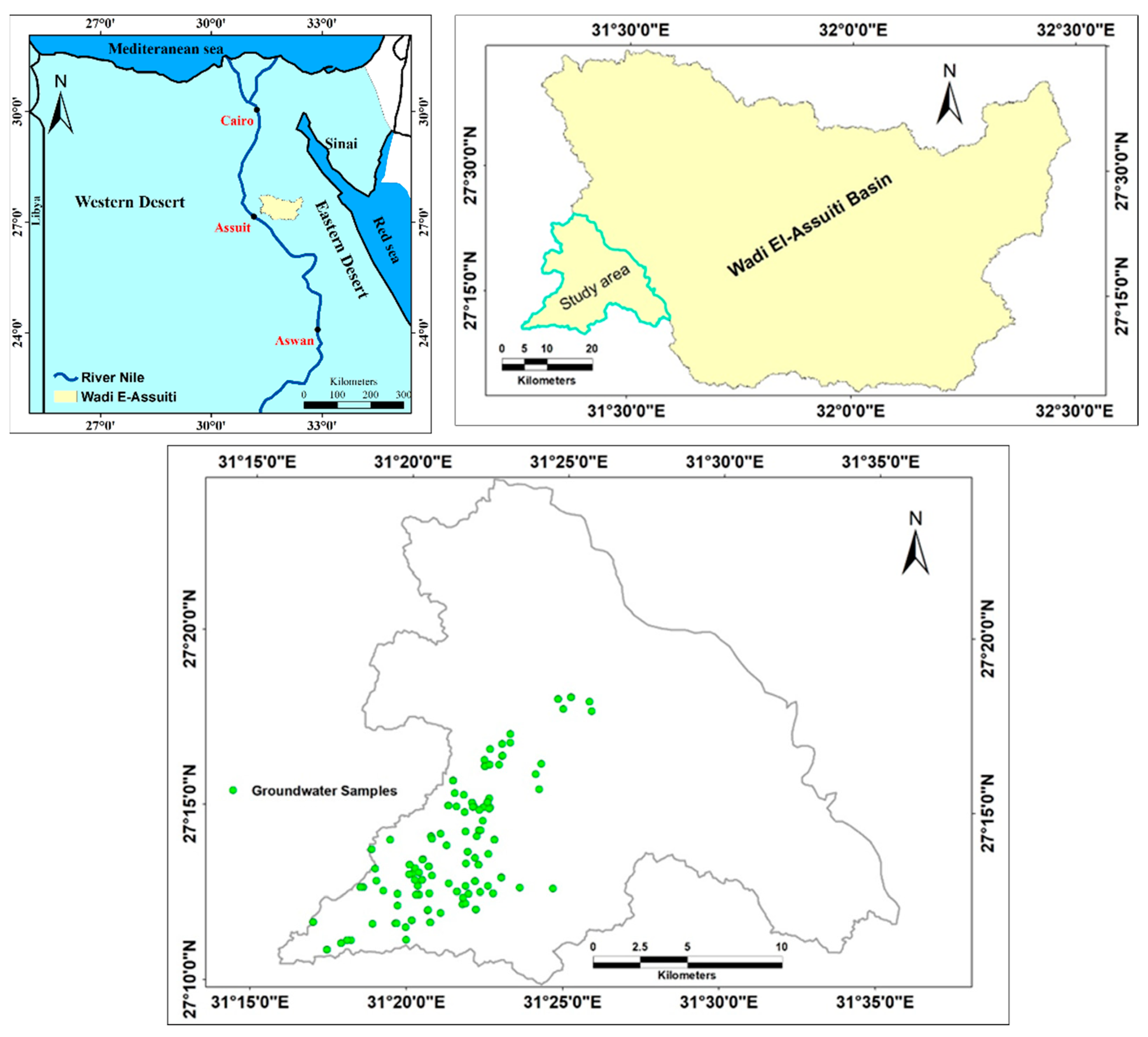
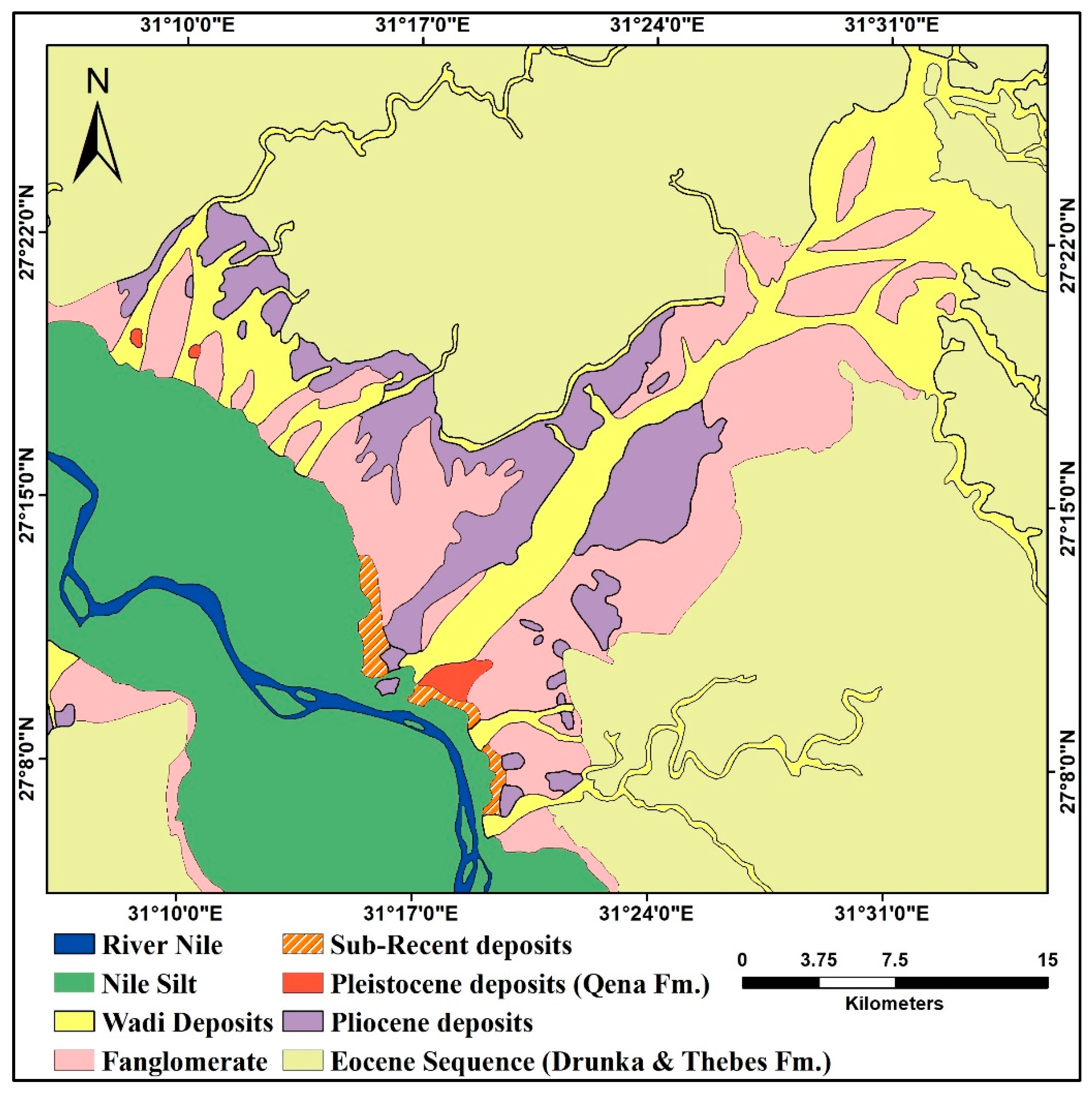

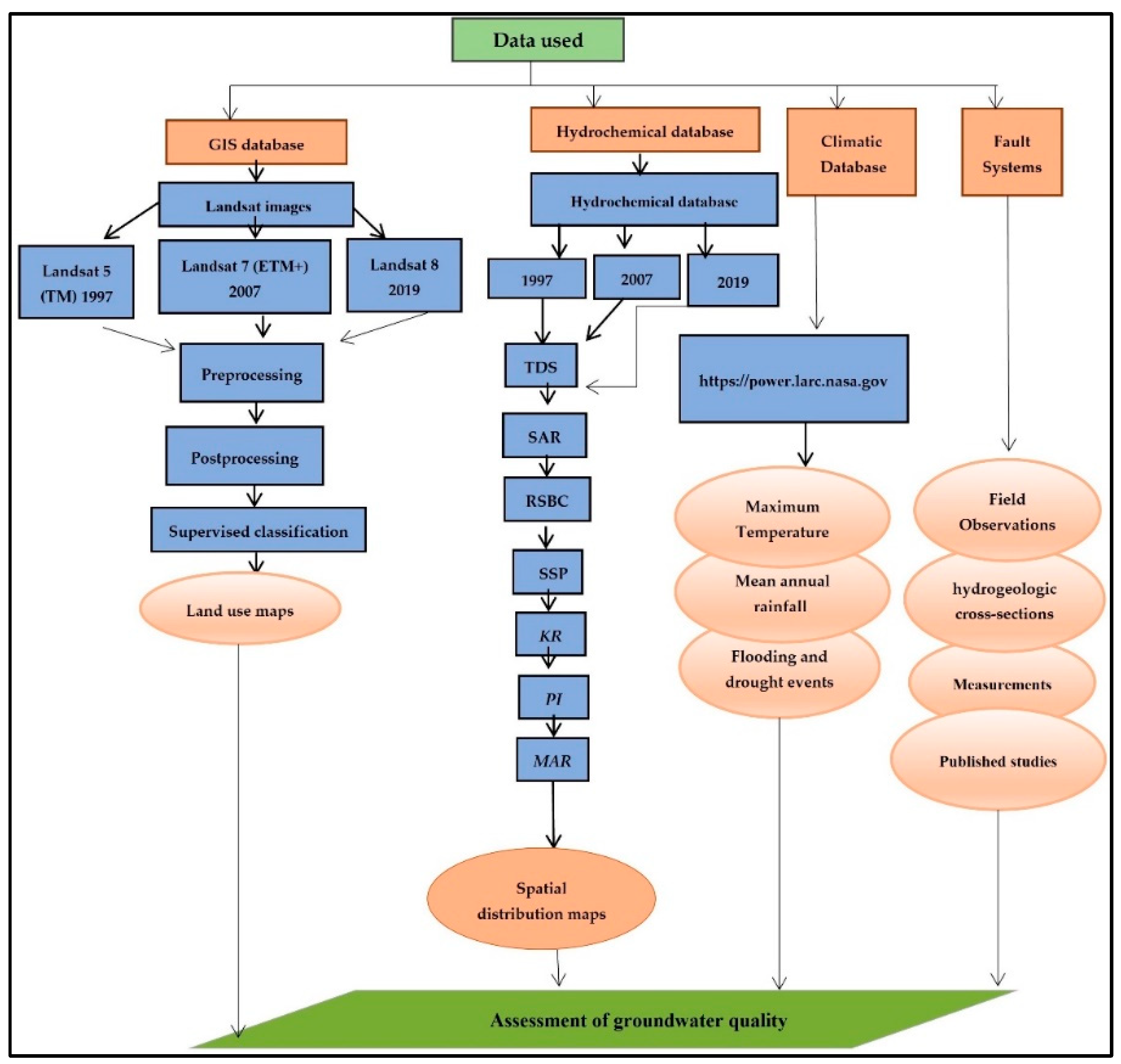

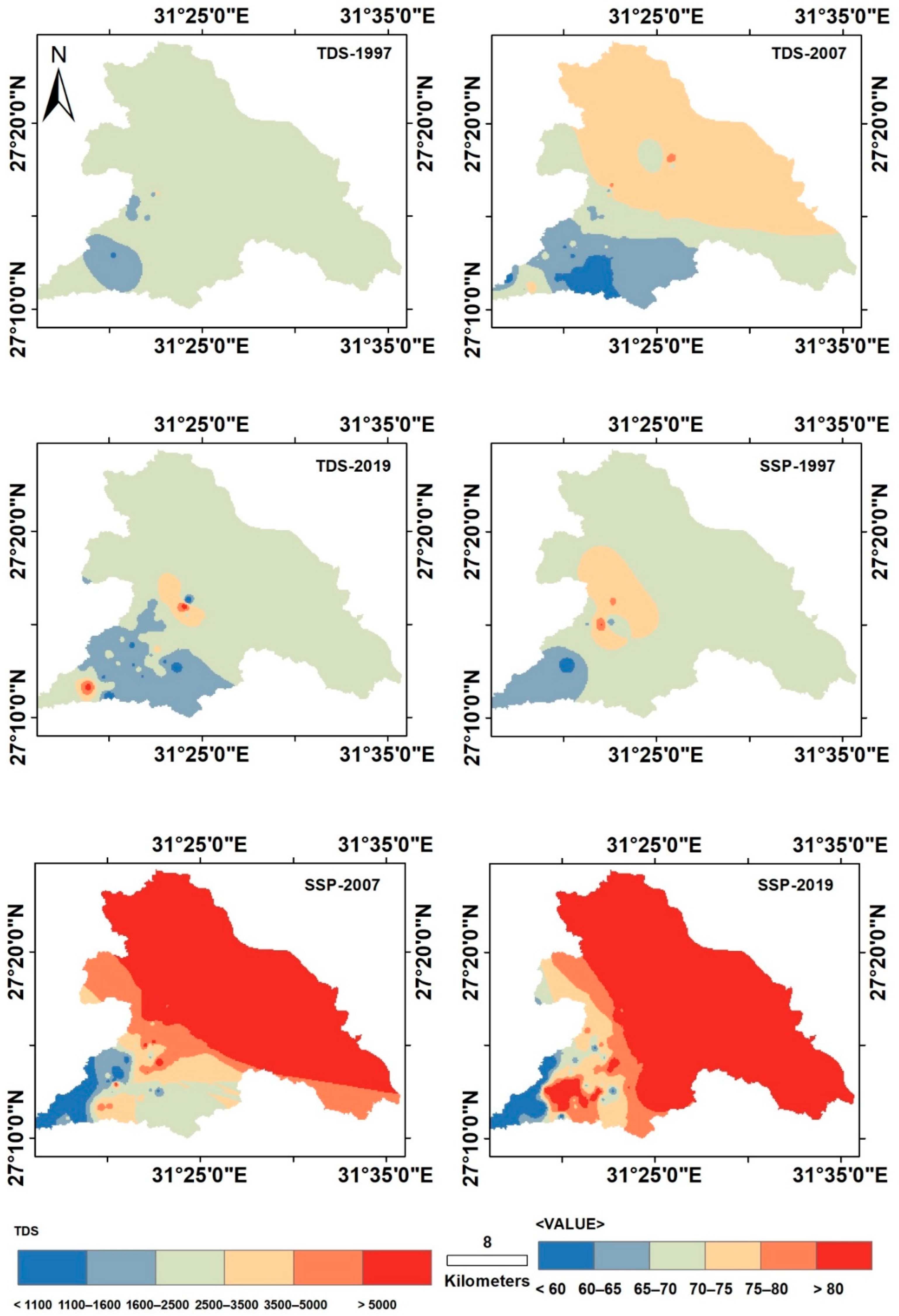
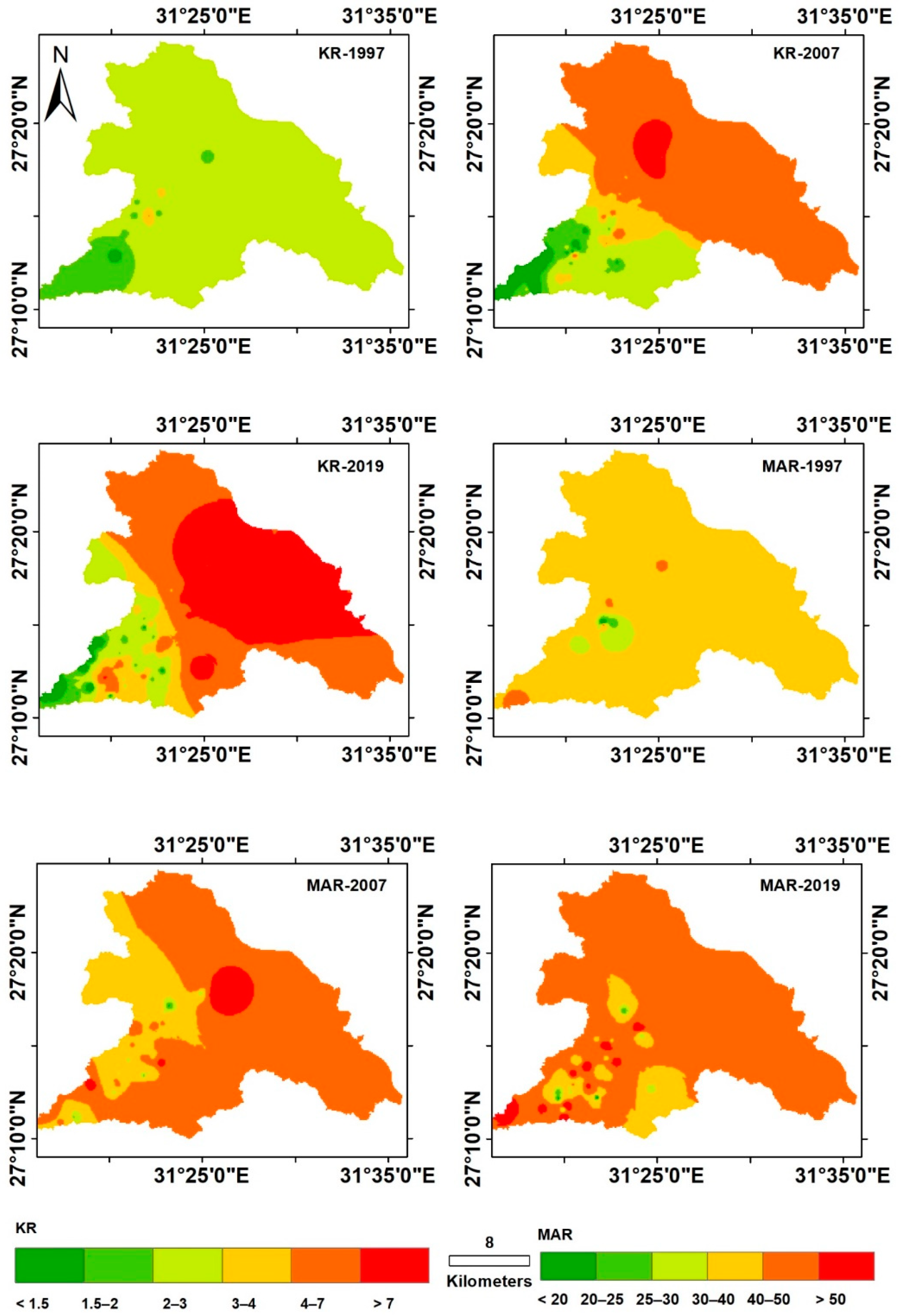
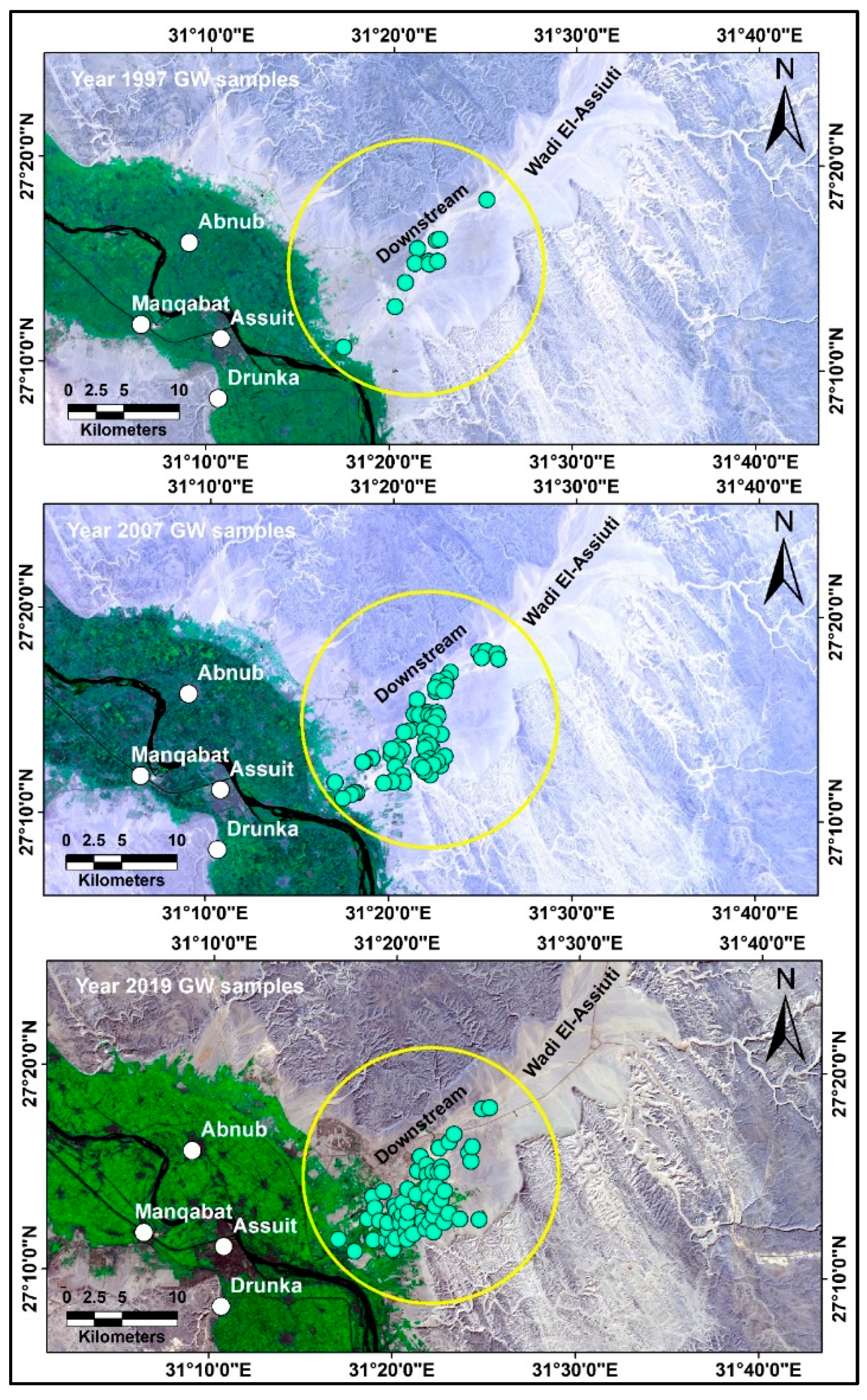
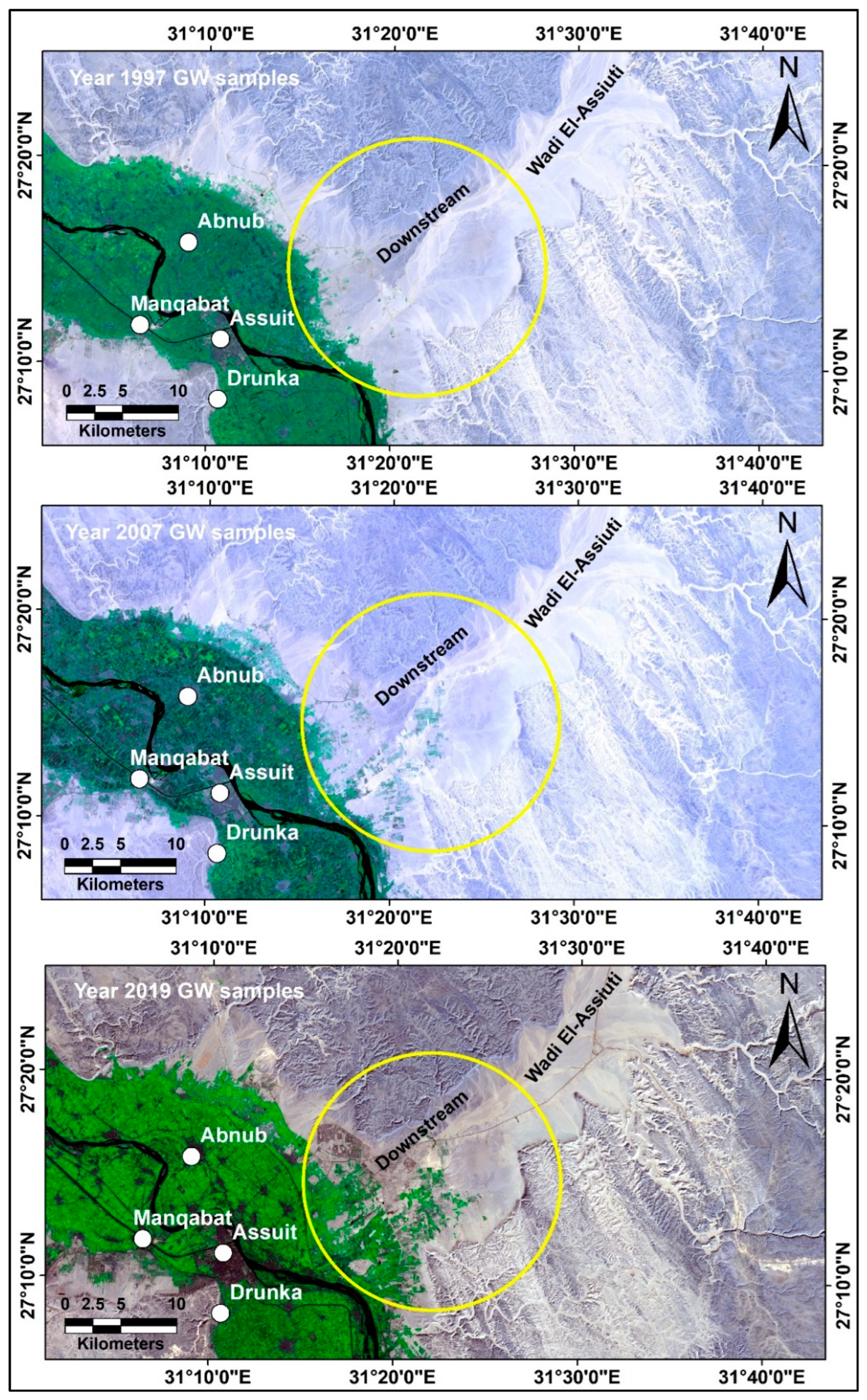


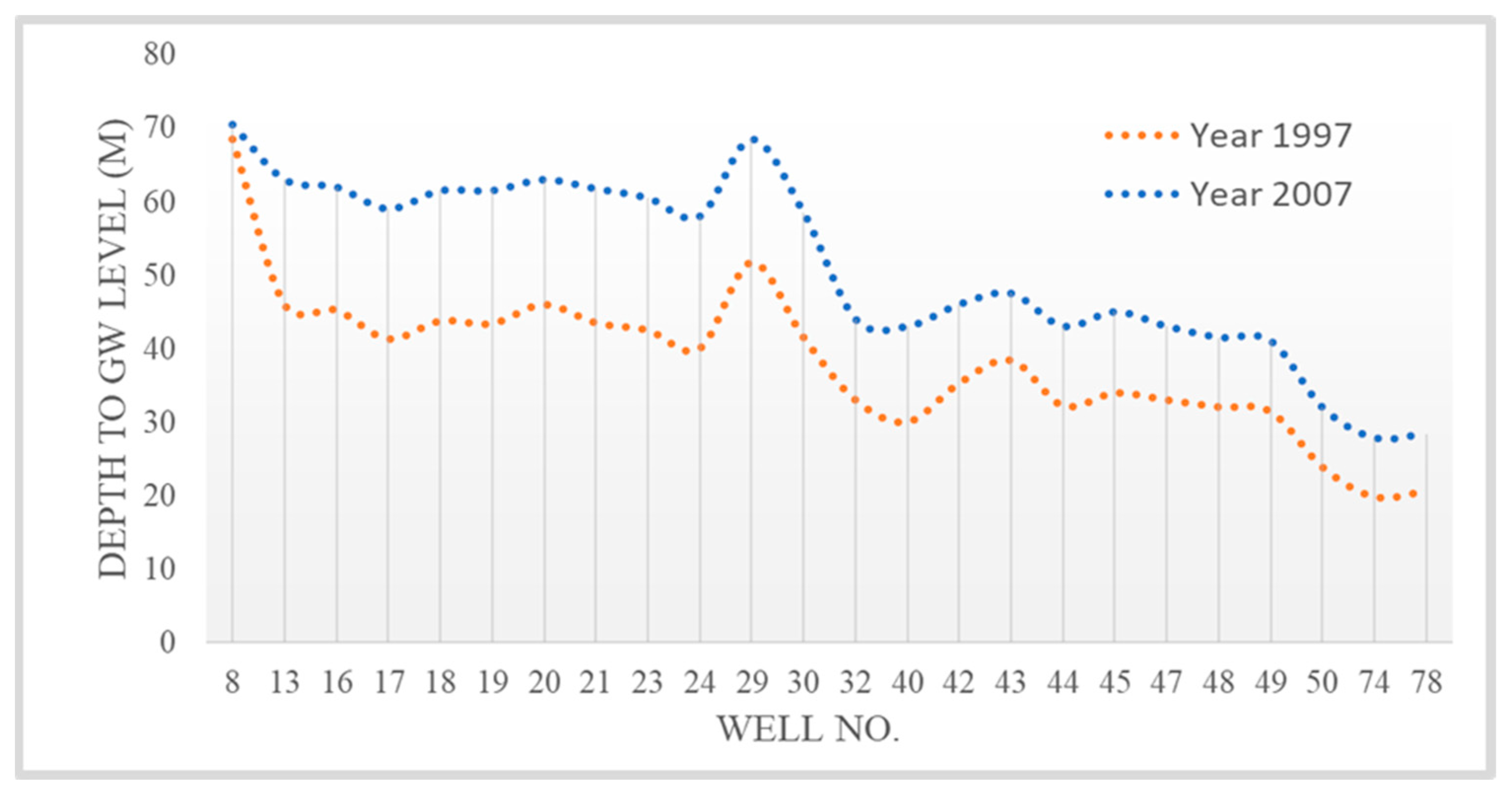
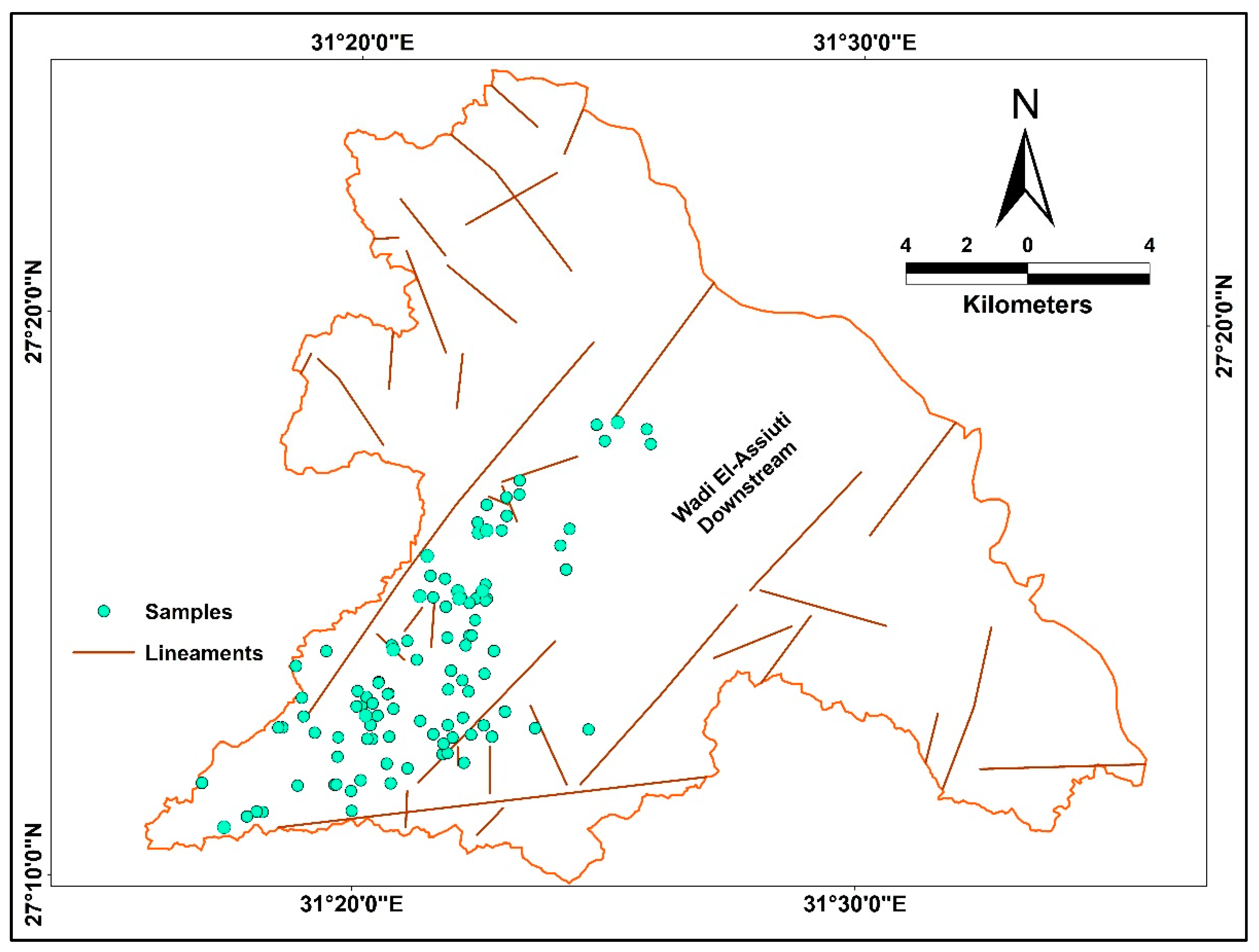
| Index | Mathematical Formula | Number |
|---|---|---|
| SAR | (1) | |
| RSBC | (2) | |
| SSP | (3) | |
| KR | (4) | |
| PI | (5) | |
| MAR | (6) |
| Satellite | Sensor | Datum | Resolution (M) | Acquisition Date | Source | Path/Row |
|---|---|---|---|---|---|---|
| Landsat 4 | TM | WGS84 | 30 m | 17 November 1997 | USGS | 176/41 |
| Landsat 7 | ETM+ | WGS84 | 30 m | 12 October 2007 | ||
| Landsat 8 | TM | WGS84 | 30 m | 10 August 2019 |
| Stats. | Quality Indices | |||||||
|---|---|---|---|---|---|---|---|---|
| Year | TDS | SAR | RSBC | SSP | KR | PI | MAR | |
| Range | 1997 | 1700.00 | 9.18 | 7.44 | 22.41 | 2.70 | 22.84 | 38.30 |
| 2007 | 3892.00 | 27.04 | 19.85 | 54.66 | 13.51 | 55.47 | 50.71 | |
| 2019 | 5272.43 | 29.14 | 30.27 | 59.50 | 14.57 | 106.37 | 58.10 | |
| Minimum | 1997 | 1080.00 | 6.15 | −9.38 | 58.03 | 1.36 | 60.16 | 6.90 |
| 2007 | 672.00 | 1.83 | −17.90 | 38.73 | 0.58 | 45.56 | 20.79 | |
| 2019 | 811.35 | 1.43 | −23.45 | 34.23 | 0.35 | 42.51 | 17.71 | |
| Maximum | 1997 | 2780.00 | 15.34 | −1.94 | 80.44 | 4.06 | 83.00 | 45.20 |
| 2007 | 4564.00 | 28.87 | 1.95 | 93.39 | 14.09 | 101.03 | 71.50 | |
| 2019 | 6083.78 | 30.57 | 6.82 | 93.73 | 14.92 | 148.88 | 75.81 | |
| Mean | 1997 | 1755.27 | 9.36 | −5.54 | 68.26 | 2.32 | 69.90 | 33.49 |
| 2007 | 1720.63 | 10.57 | −3.78 | 70.40 | 3.02 | 74.74 | 40.30 | |
| 2019 | 1726.10 | 10.47 | −0.90 | 73.99 | 3.63 | 90.44 | 42.21 | |
| Std. Deviation | 1997 | 474.87 | 2.70 | 2.11 | 7.45 | 0.91 | 7.69 | 11.24 |
| 2007 | 769.39 | 5.61 | 3.75 | 11.35 | 2.13 | 13.02 | 9.70 | |
| 2019 | 948.38 | 6.02 | 4.94 | 13.55 | 2.70 | 28.72 | 12.20 | |
| Year | Agriculture | Urban | Barren Soil | Barren Rock |
|---|---|---|---|---|
| 1997 | 0.91% | 1.08% | 27.91% | 70.10% |
| 2007 | 3.84% | 1.71% | 24.83% | 69.62% |
| 2019 | 6.29% | 4.14% | 20.63% | 68.94% |
| Event | Flash-Flood Affected Zones | Results |
|---|---|---|
| 2015 | Wadi El-Assiuti and Wadi Qena | Destroyed houses on east side of Nile Valley |
| 1997 | Upper Egypt: Aswan, Sohag, Asyut, Minia, and Qena | 23 deaths, 260 houses destroyed, andthousands of hectares flooded |
| 1975 | Wadi Taref, Wadi El-Assiuti, and Sohag Governorate | 180 houses destroyed and 1500 citizens displaced |
Publisher’s Note: MDPI stays neutral with regard to jurisdictional claims in published maps and institutional affiliations. |
© 2022 by the authors. Licensee MDPI, Basel, Switzerland. This article is an open access article distributed under the terms and conditions of the Creative Commons Attribution (CC BY) license (https://creativecommons.org/licenses/by/4.0/).
Share and Cite
El-Magd, S.A.A.; Ahmed, H.; Pham, Q.B.; Linh, N.T.T.; Anh, D.T.; Elkhrachy, I.; Masoud, A.M. Possible Factors Driving Groundwater Quality and Its Vulnerability to Land Use, Floods, and Droughts Using Hydrochemical Analysis and GIS Approaches. Water 2022, 14, 4073. https://doi.org/10.3390/w14244073
El-Magd SAA, Ahmed H, Pham QB, Linh NTT, Anh DT, Elkhrachy I, Masoud AM. Possible Factors Driving Groundwater Quality and Its Vulnerability to Land Use, Floods, and Droughts Using Hydrochemical Analysis and GIS Approaches. Water. 2022; 14(24):4073. https://doi.org/10.3390/w14244073
Chicago/Turabian StyleEl-Magd, Sherif Ahmed Abu, Hanaa Ahmed, Quoc Bao Pham, Nguyen Thi Thuy Linh, Duong Tran Anh, Ismail Elkhrachy, and Ahmed M. Masoud. 2022. "Possible Factors Driving Groundwater Quality and Its Vulnerability to Land Use, Floods, and Droughts Using Hydrochemical Analysis and GIS Approaches" Water 14, no. 24: 4073. https://doi.org/10.3390/w14244073
APA StyleEl-Magd, S. A. A., Ahmed, H., Pham, Q. B., Linh, N. T. T., Anh, D. T., Elkhrachy, I., & Masoud, A. M. (2022). Possible Factors Driving Groundwater Quality and Its Vulnerability to Land Use, Floods, and Droughts Using Hydrochemical Analysis and GIS Approaches. Water, 14(24), 4073. https://doi.org/10.3390/w14244073










